Abstract
1. A brief downward, stepwise displacement applied to the outstretched finger gives rise to a train of approximately sinusoidal movements of it, lasting often more than 1 sec. The frequency of these waves is the same, in any one subject, as that of physiological tremor.
2. The oscillations are regular in form, and bear a constant phase relation to the applied displacement; they can be summated using an averaging computer (Biomac 1000) triggered by the mechanical stimulus.
3. The oscillations are altered in the same way as is physiological tremor by a number of factors. Cooling the arm before recording lowers the frequency, warming raises it, while the application of an arterial cuff decreases the amplitude and tends to elevate the frequency. These factors have effects of similar magnitude on both the oscillations and the tremor.
It thus appears highly likely that the waves produced by a mechanical input and physiological tremor waves are due to the same process, namely oscillation in an underdamped servo-system.
4. The oscillation is not due simply to the mechanical, die-away resonance of the finger, because bursts of muscle action potentials can be recorded in phase with the finger movements both in the wave train evoked by the mechanical displacement and during normal tremor.
5. It is concluded that physiological tremor in the 8-12 c/s band is due to oscillation in the stretch reflex servo-loop.
Full text
PDF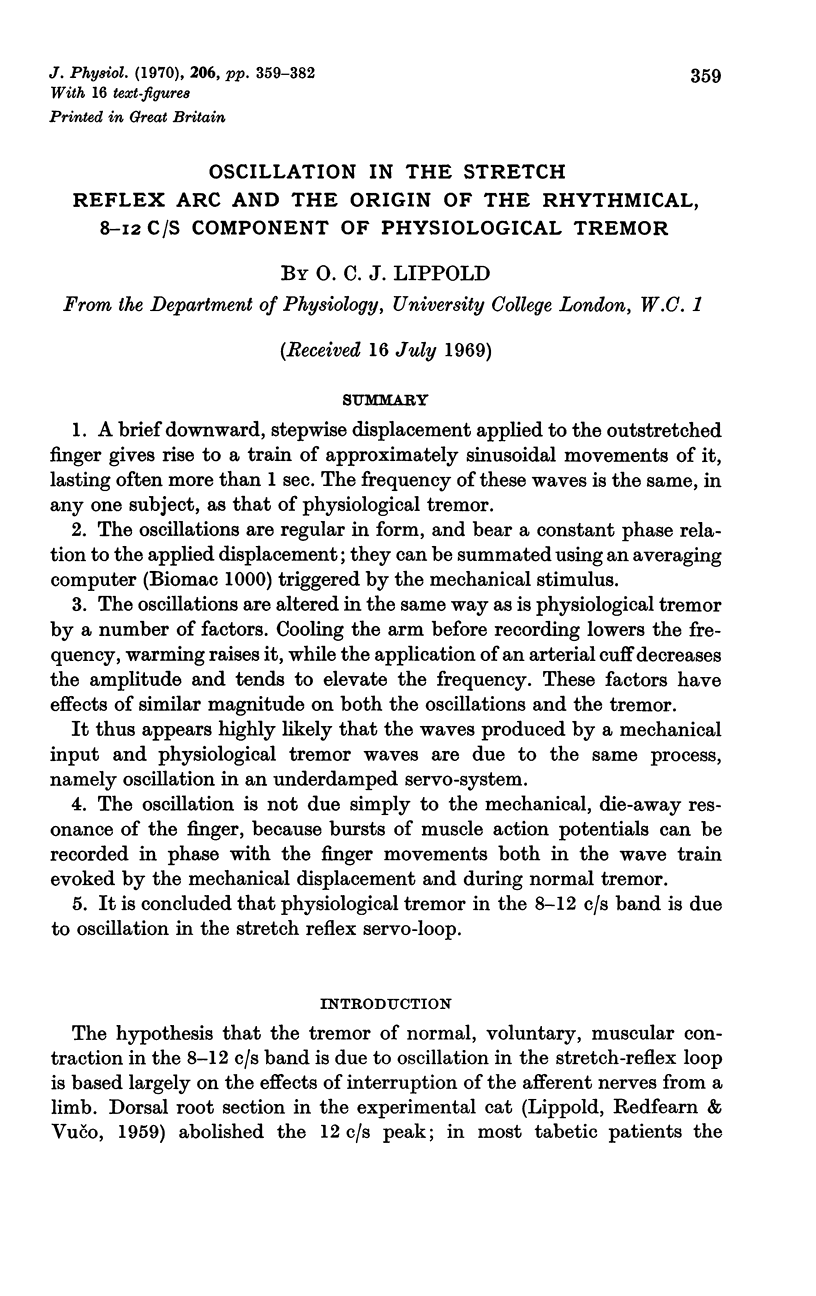
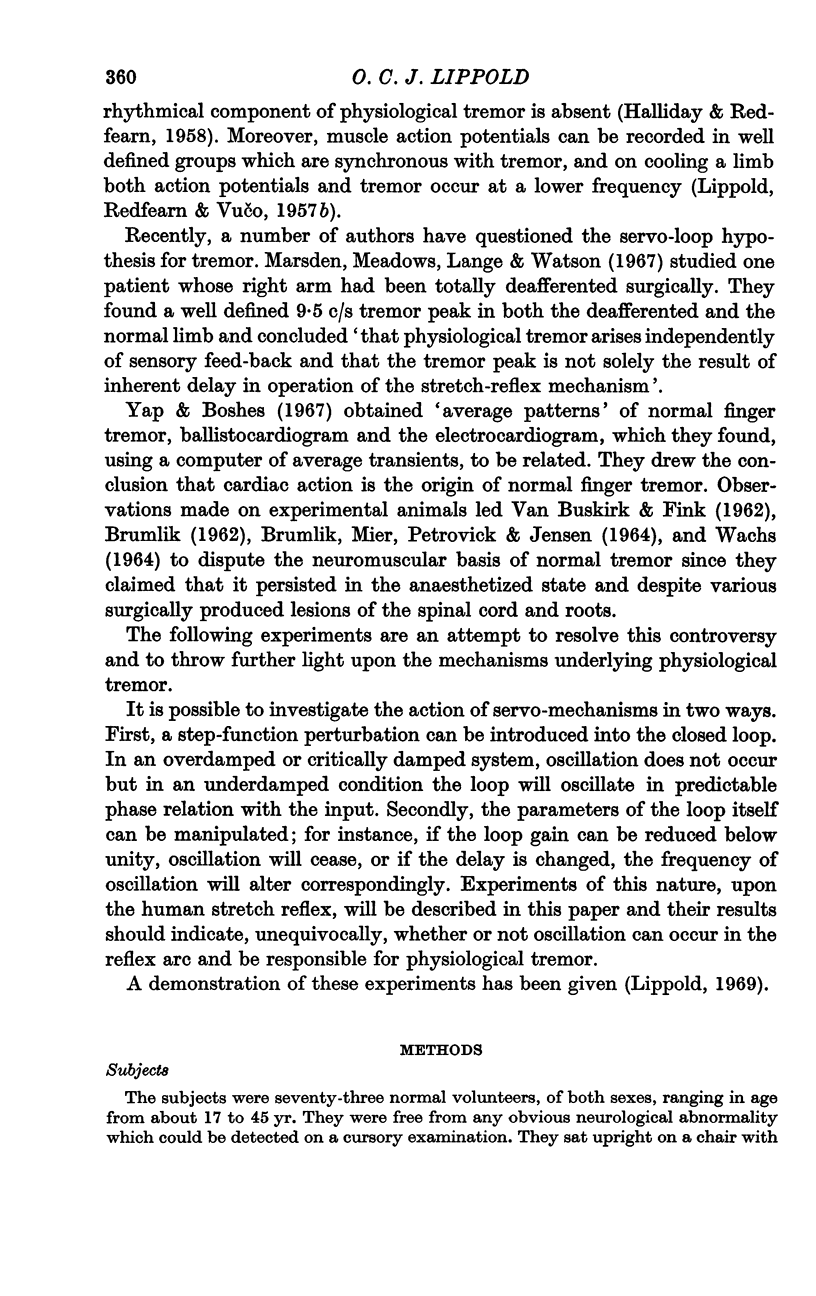
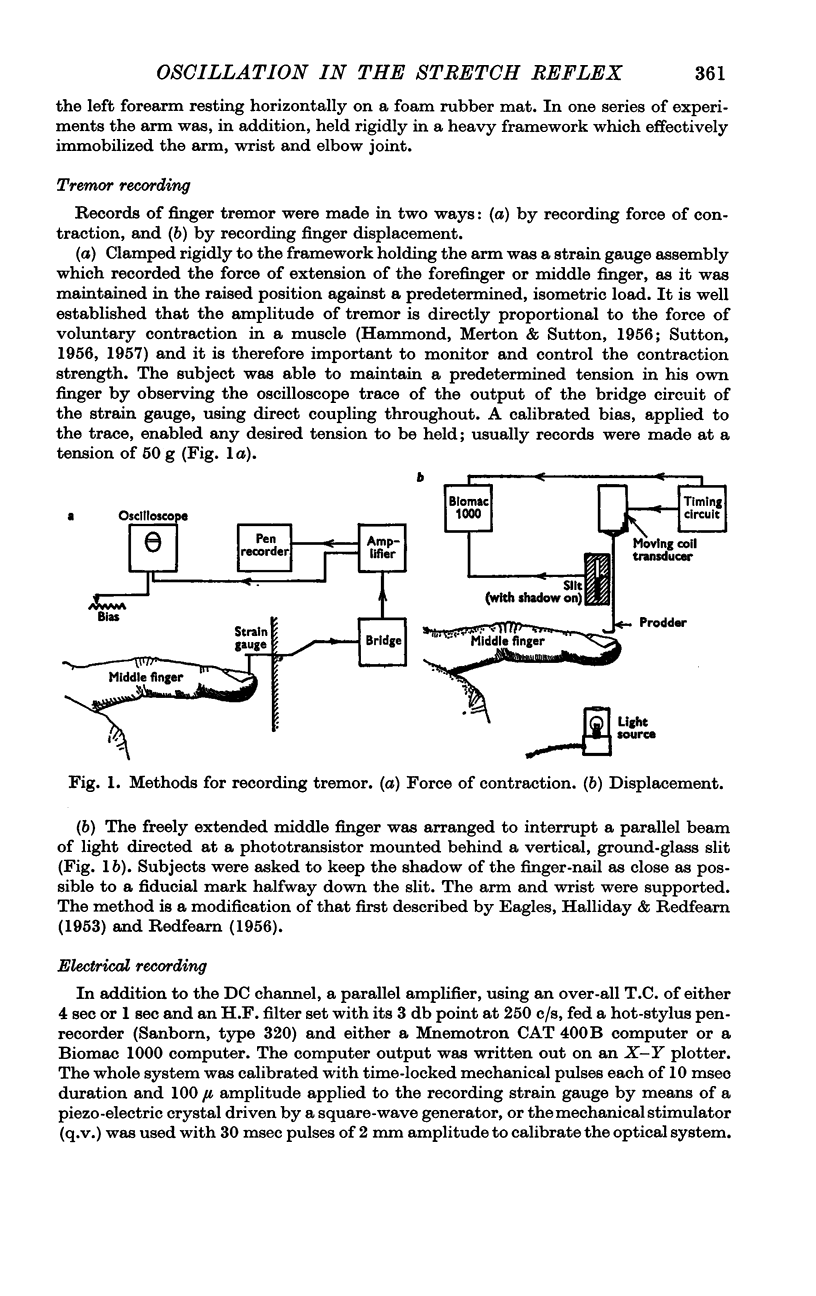
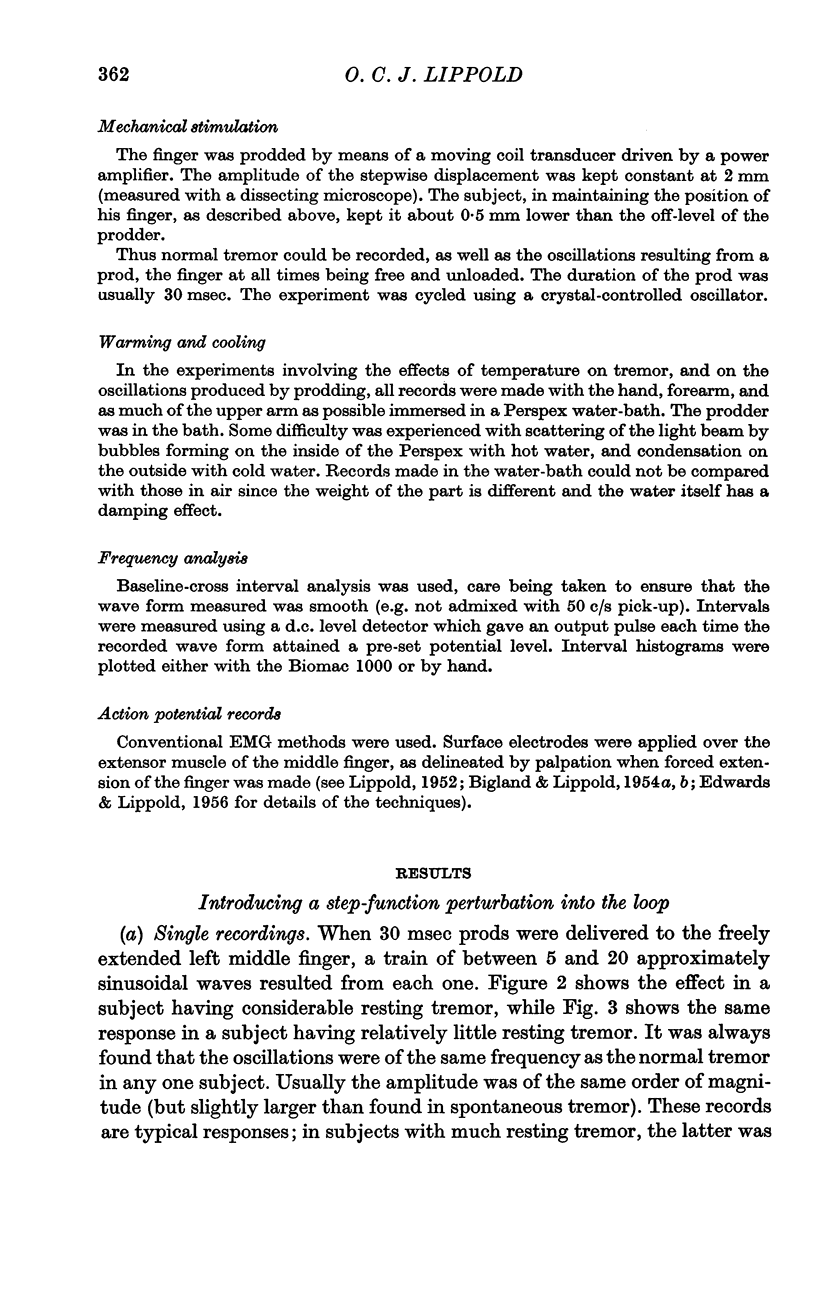
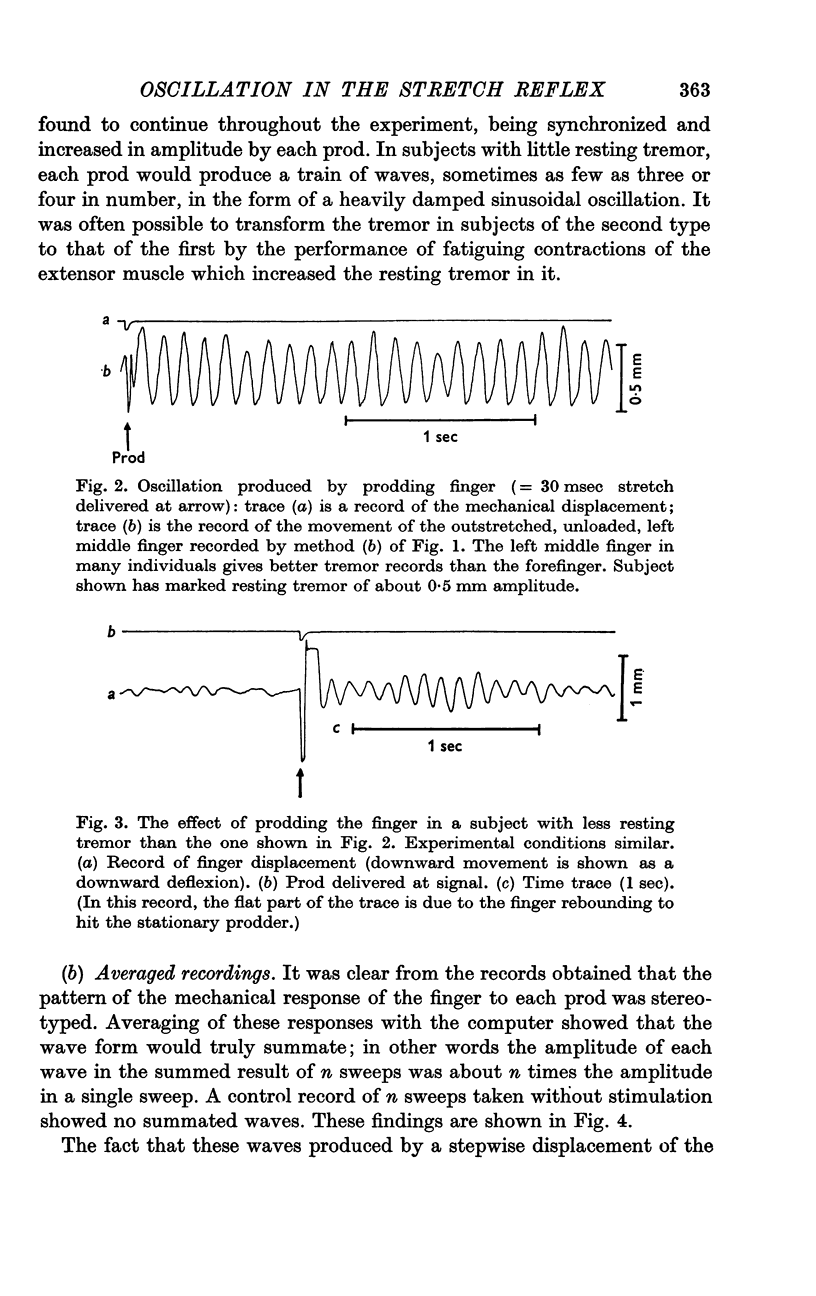
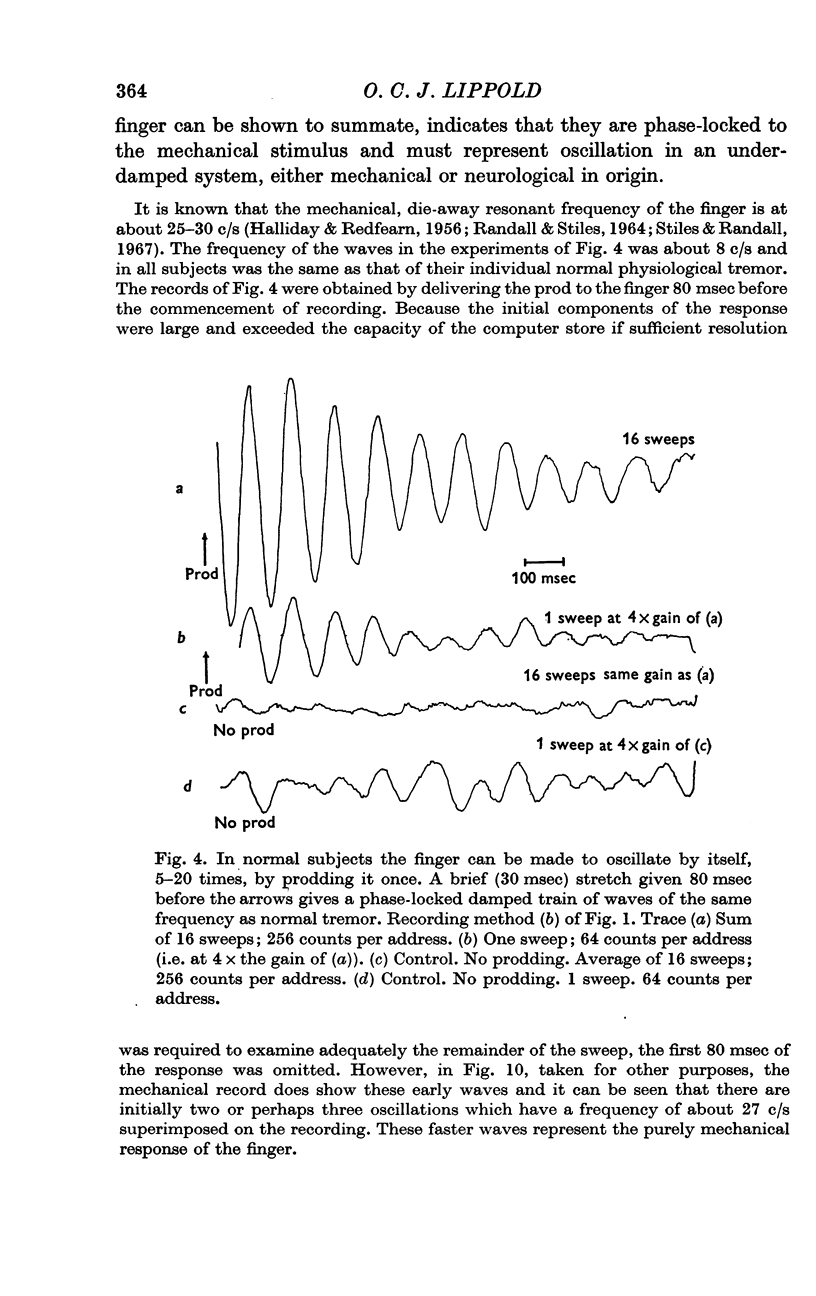
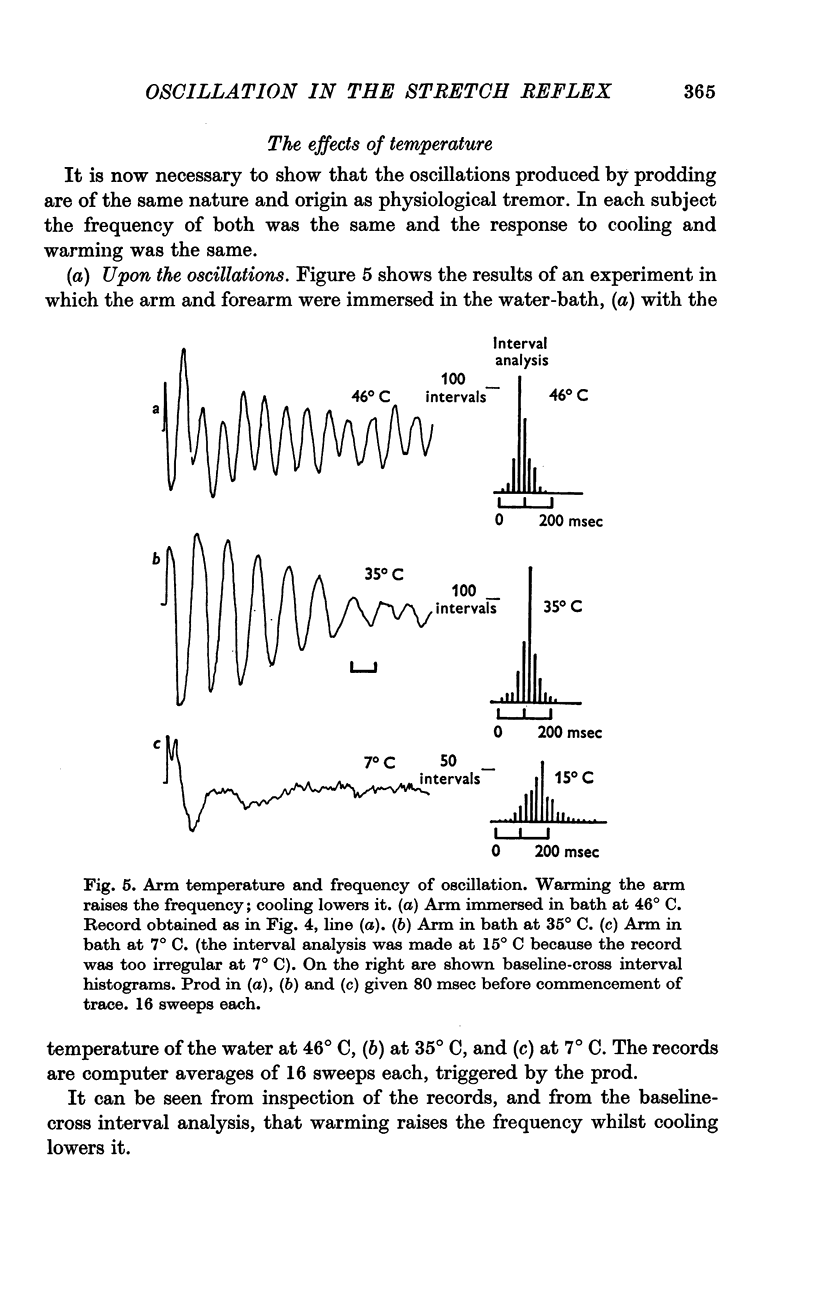
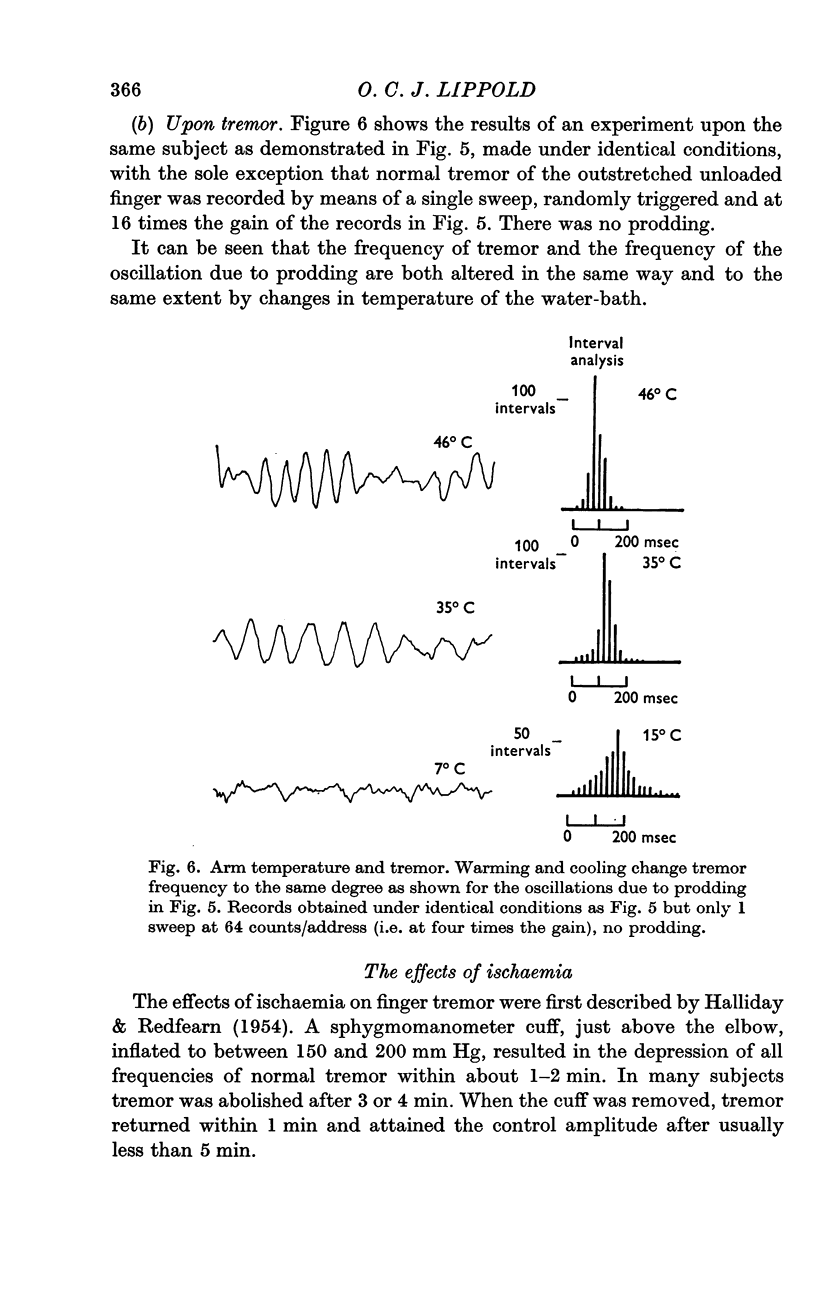
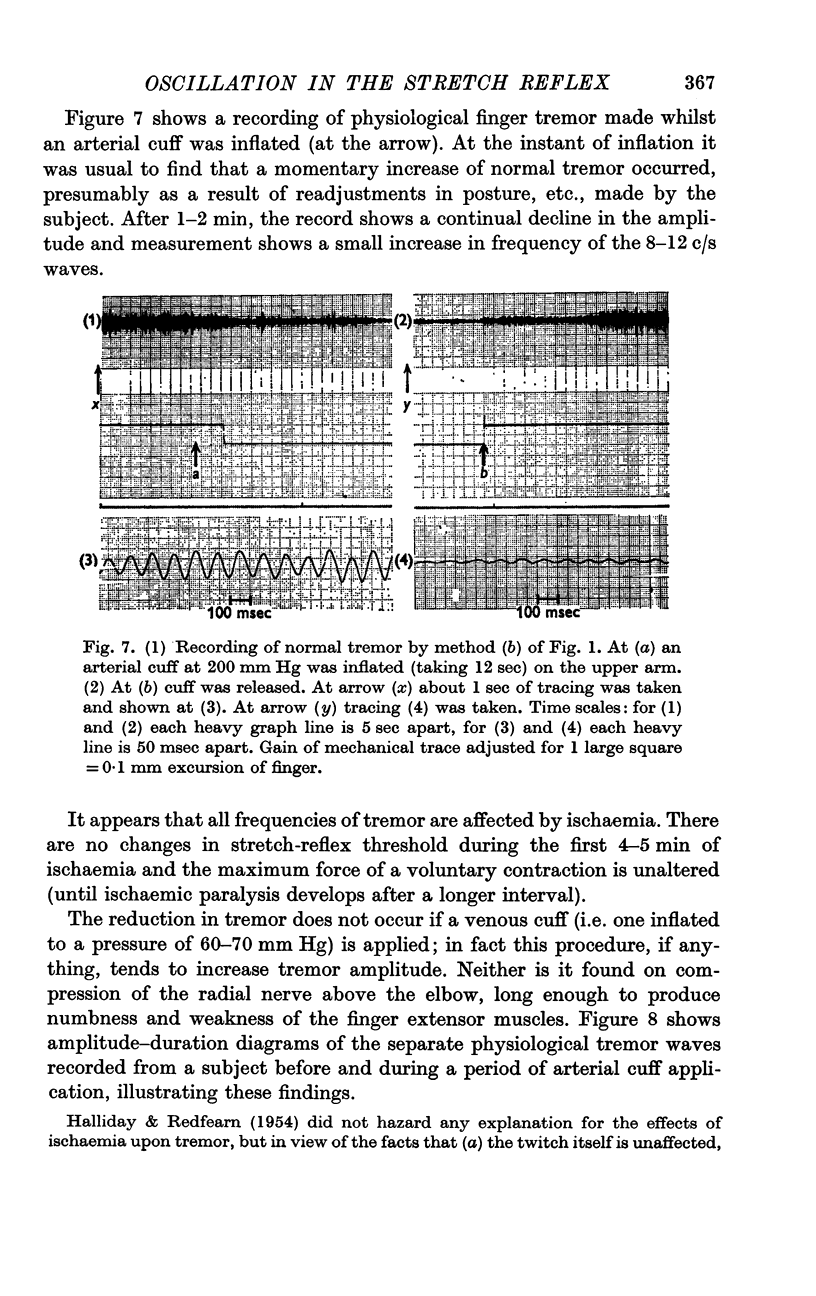
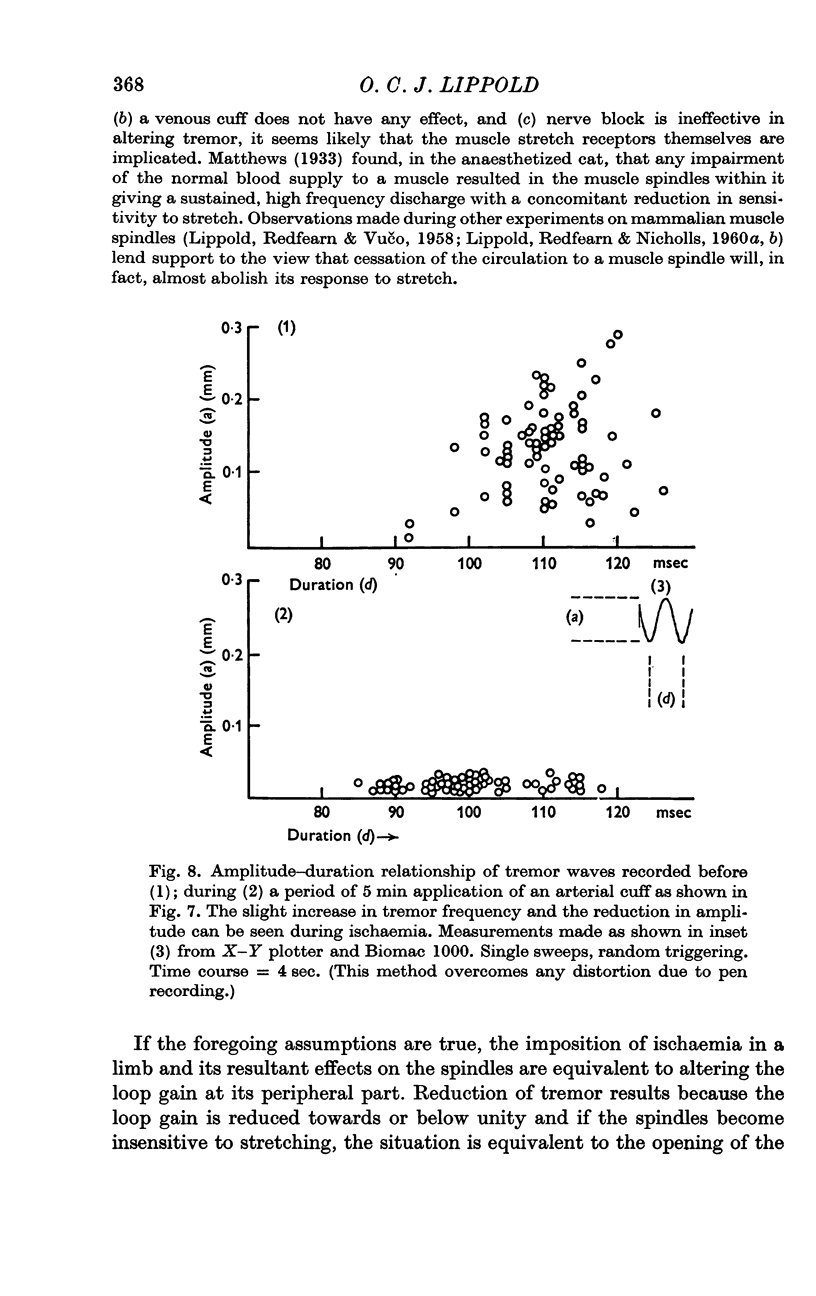
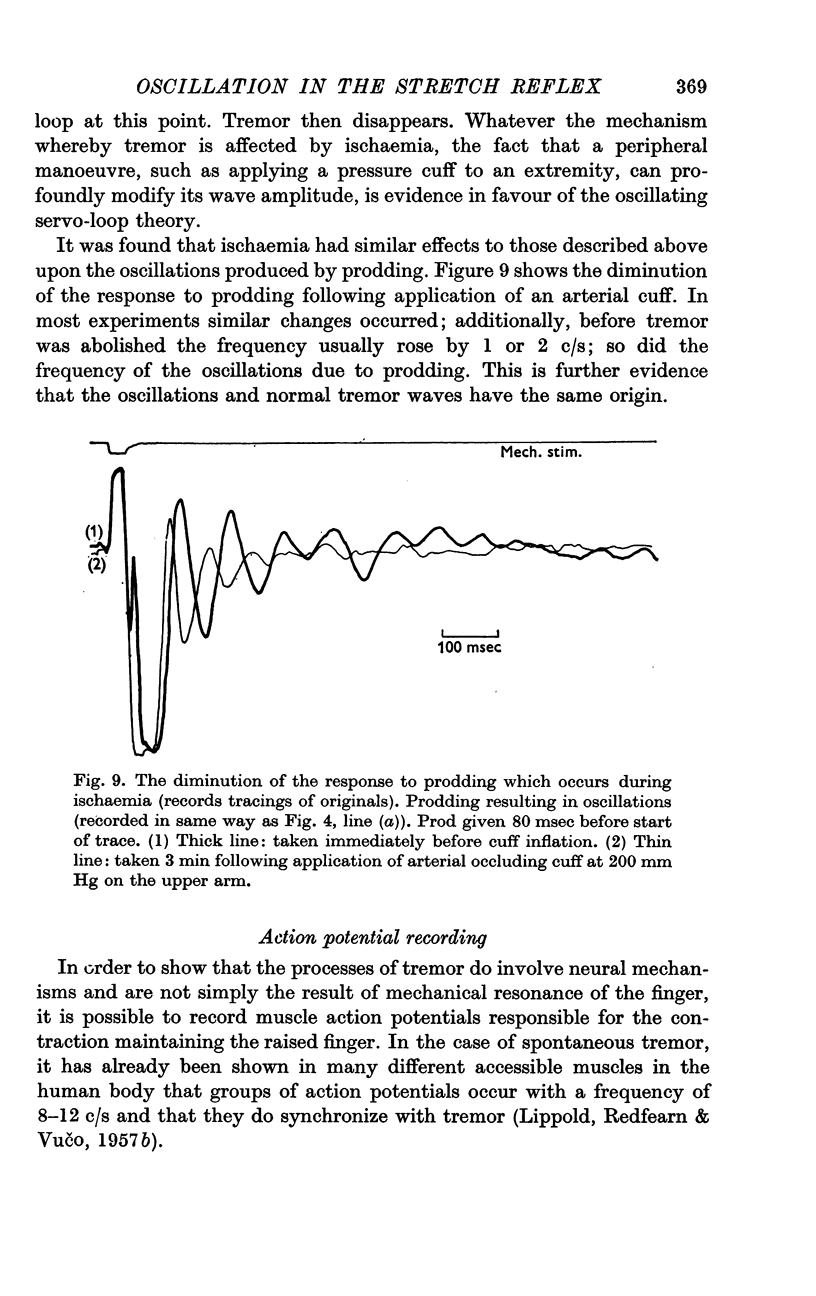
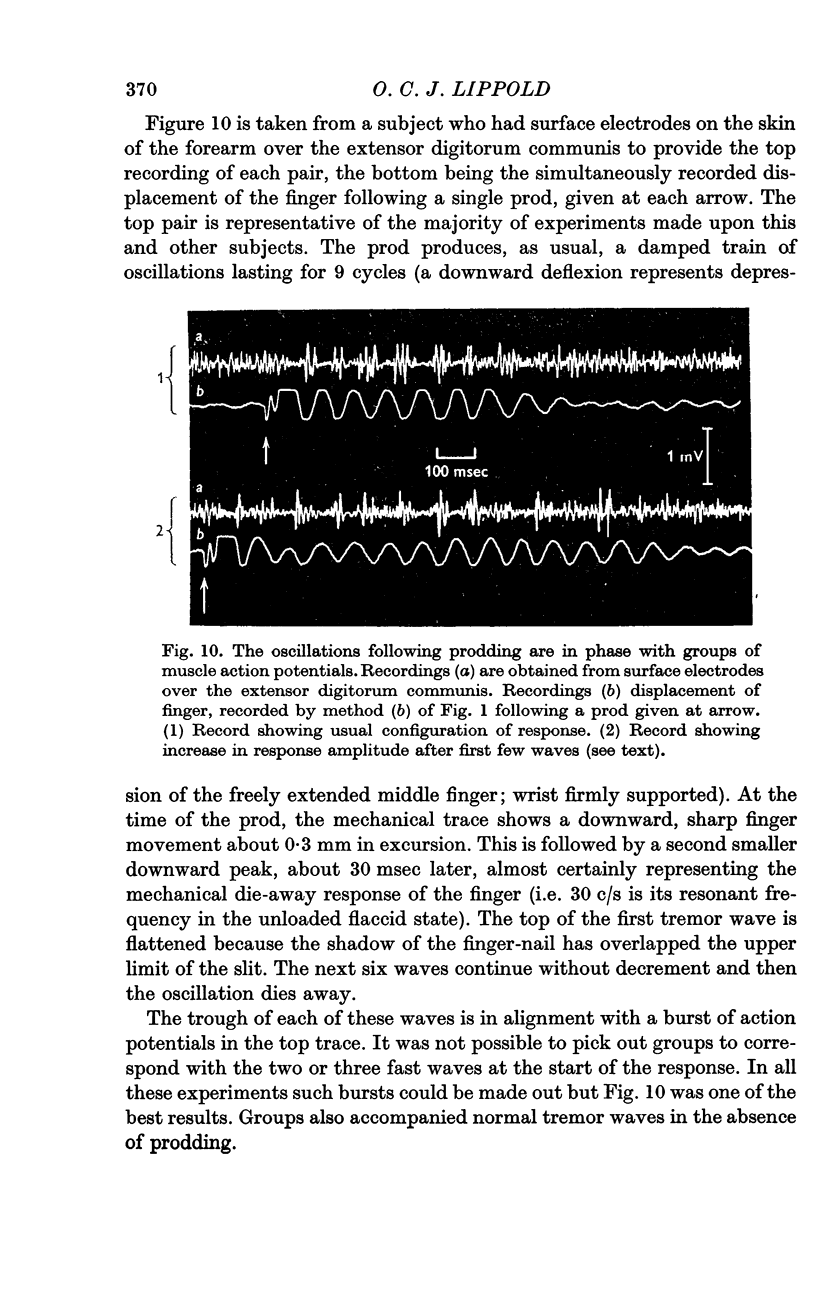
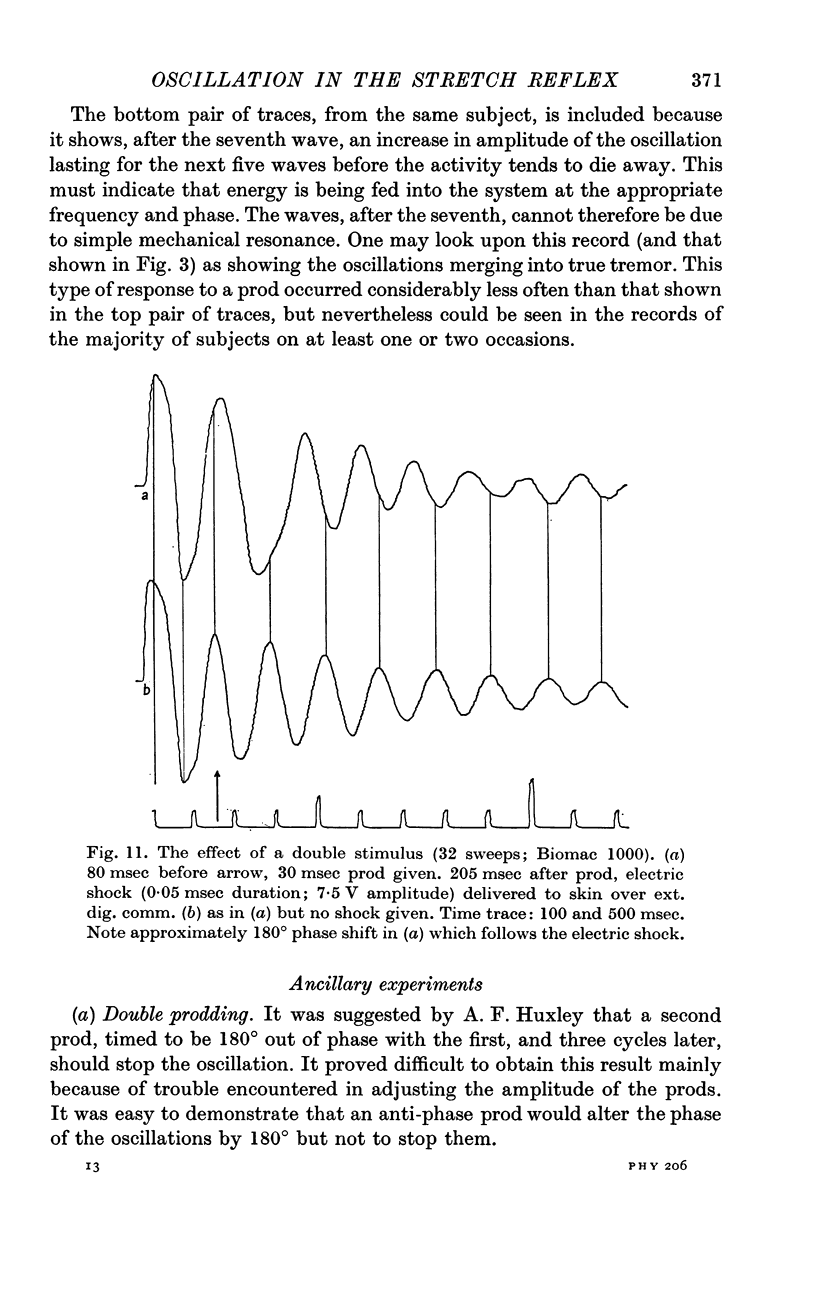
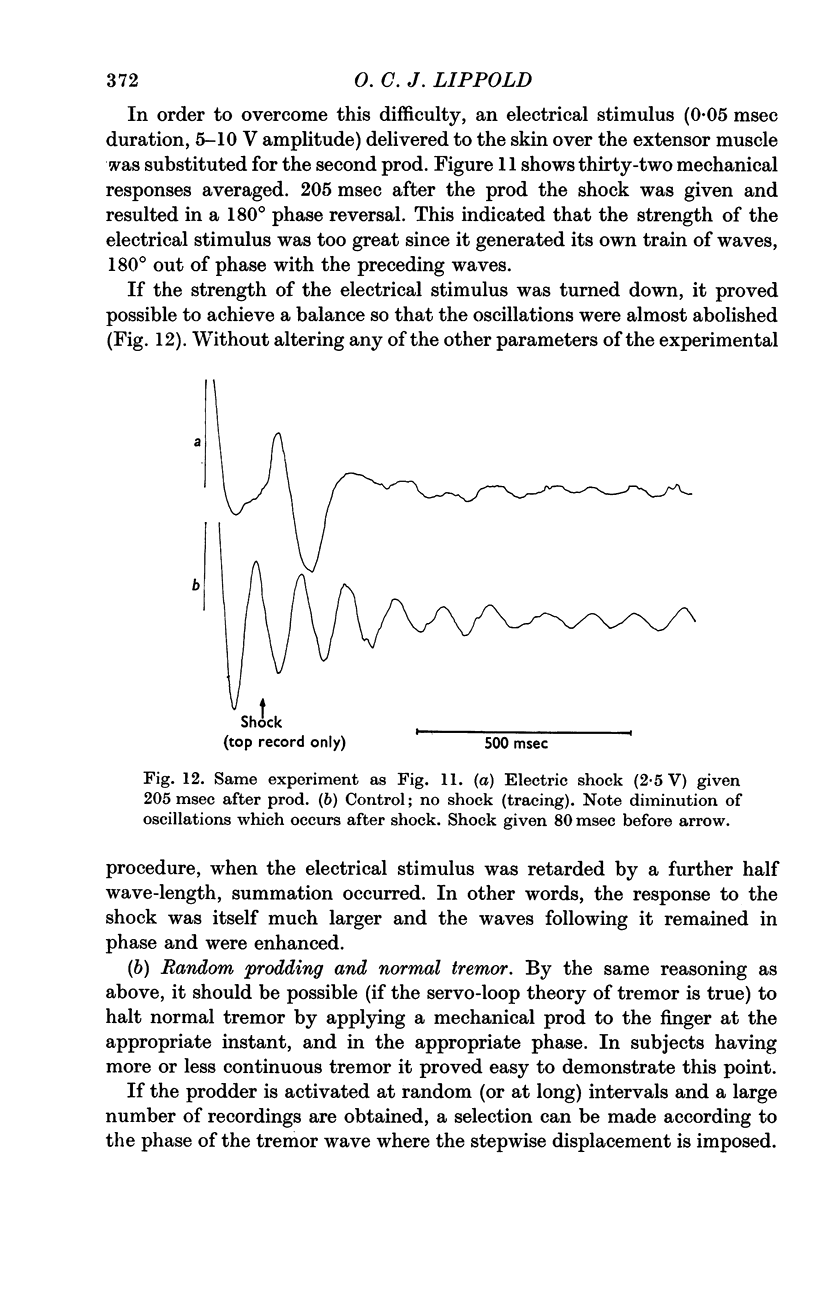
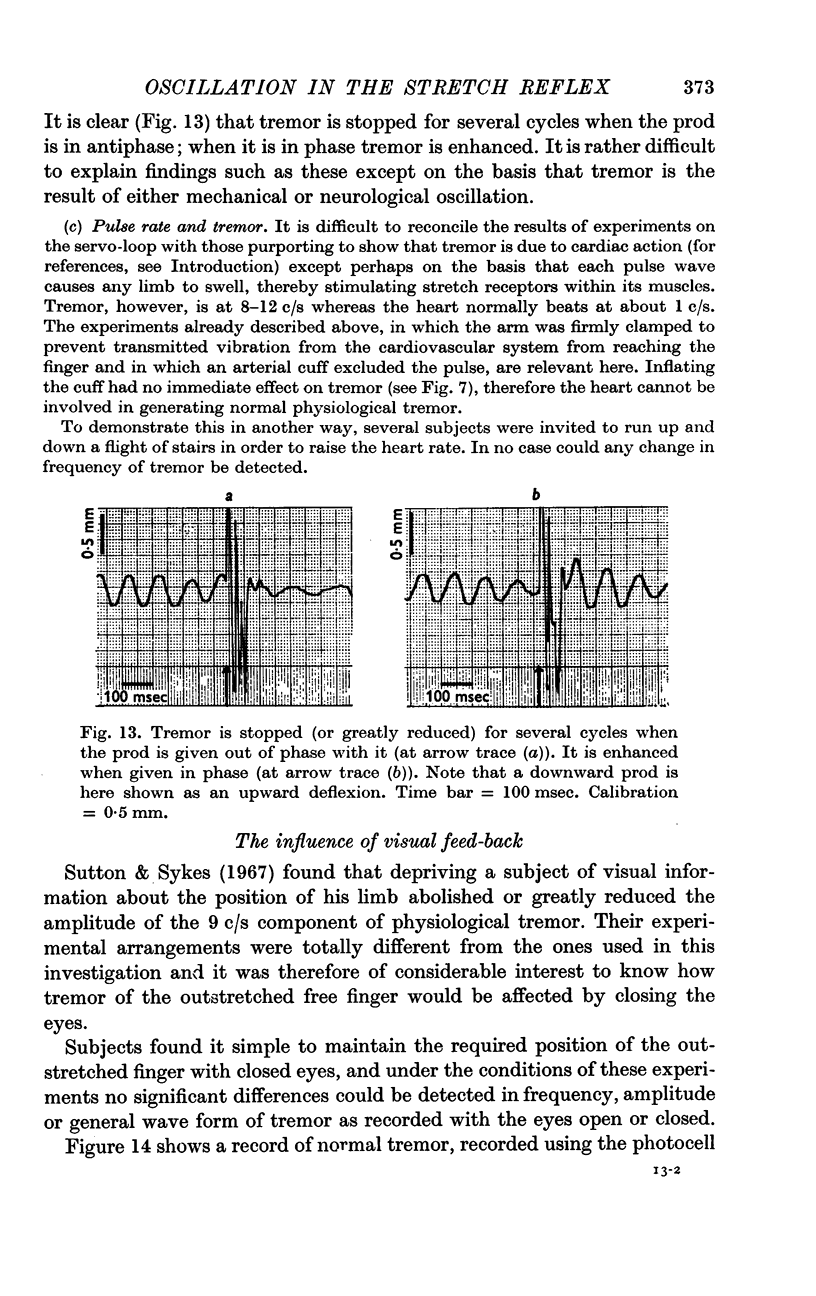
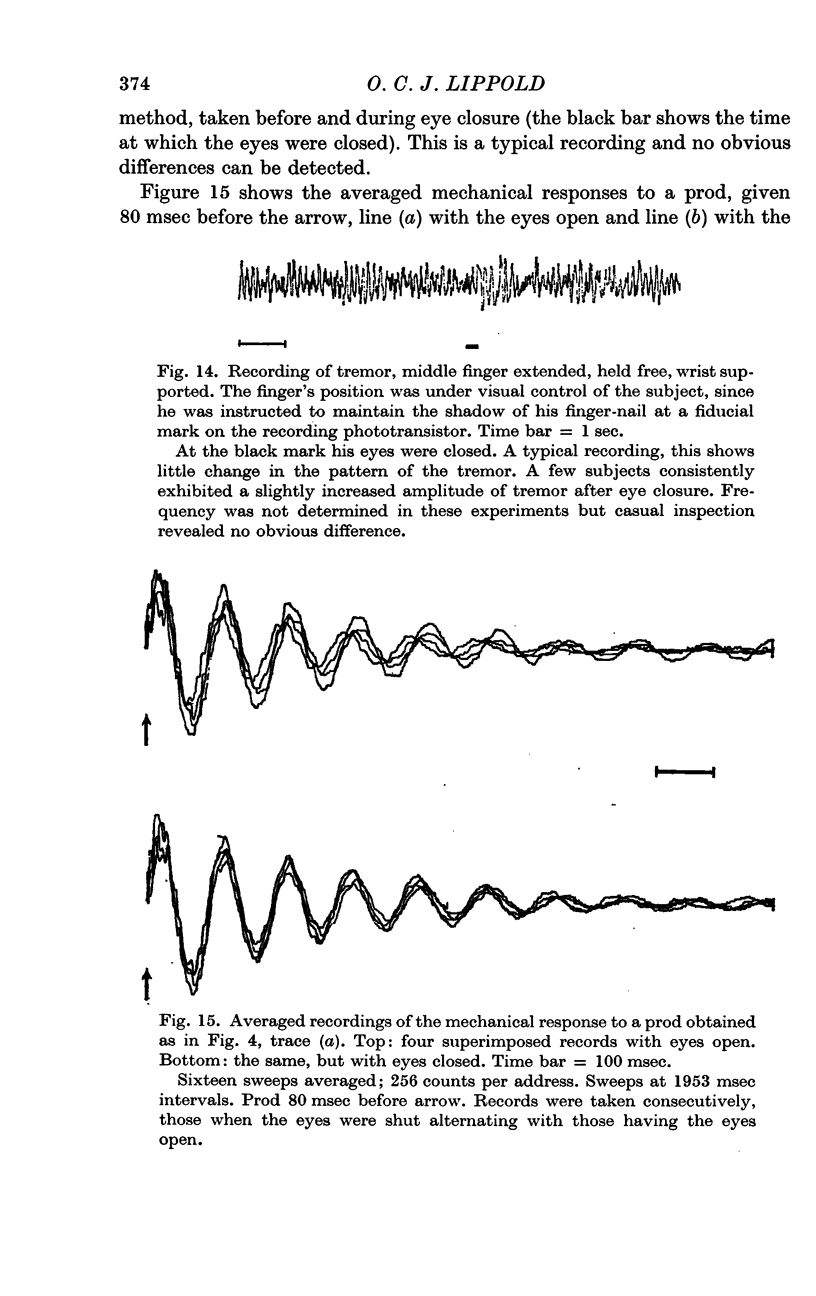
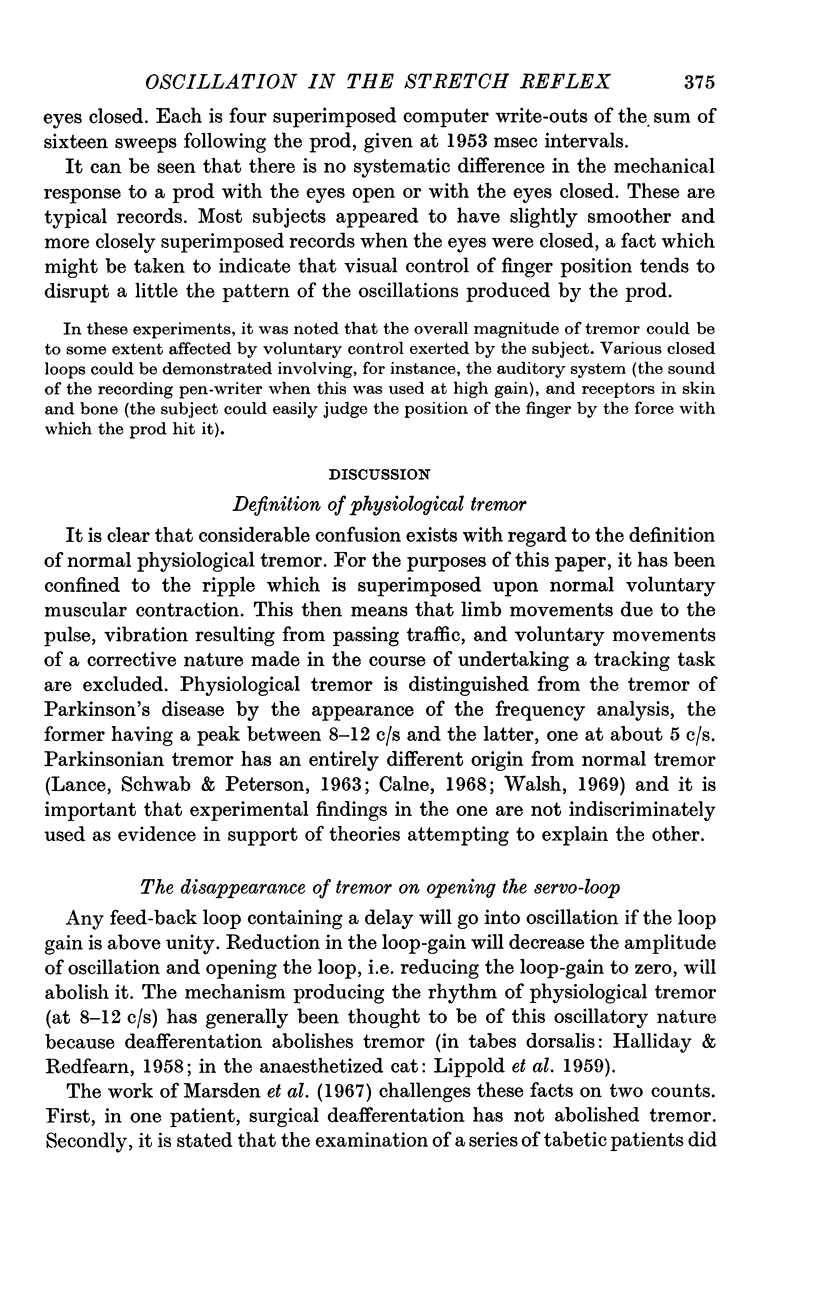
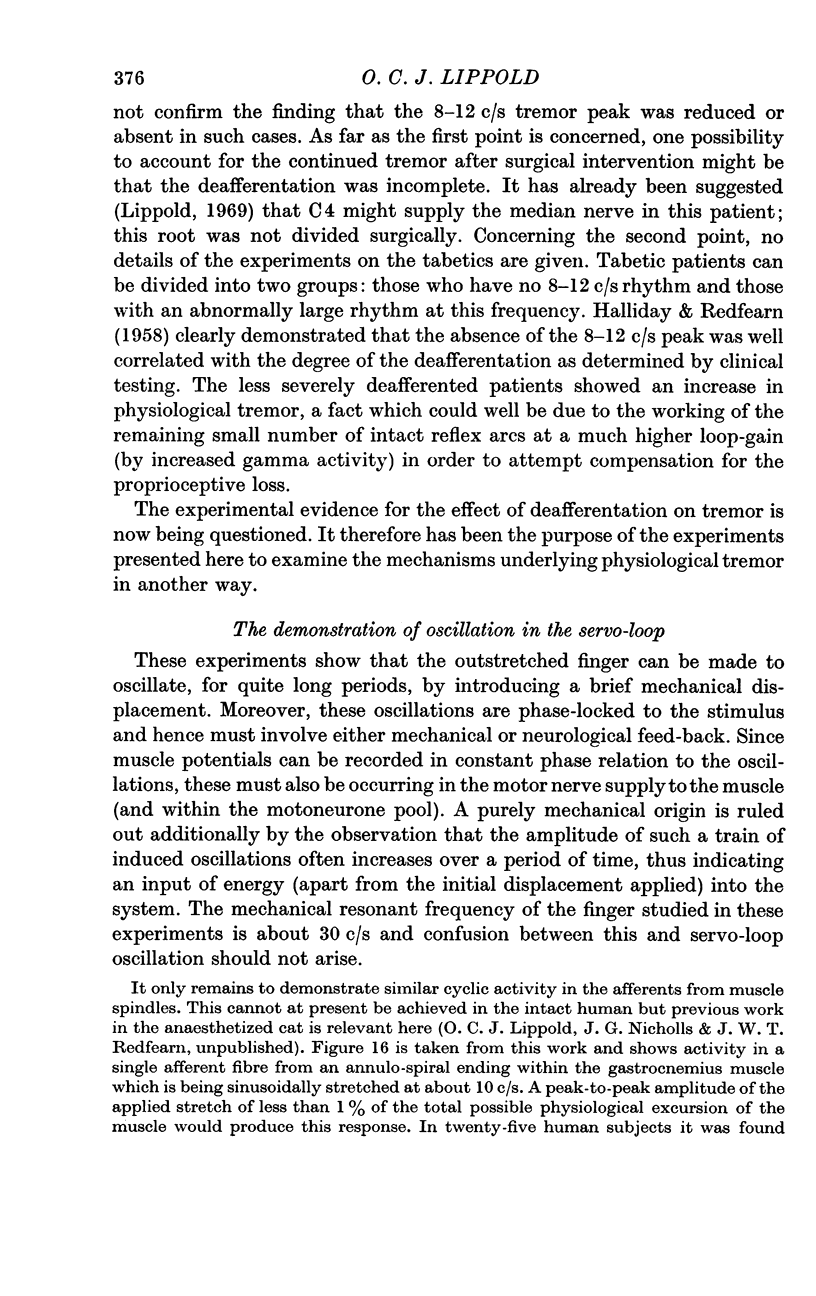
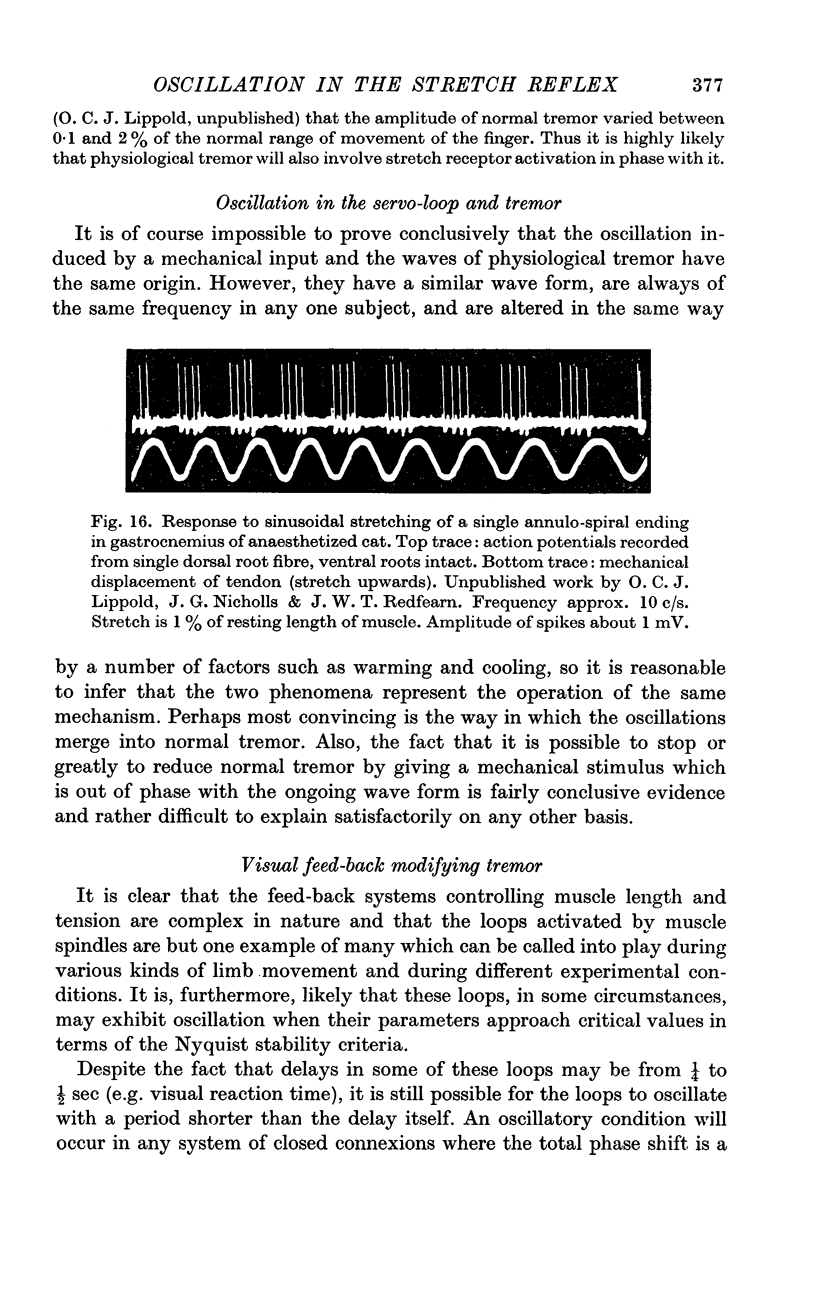
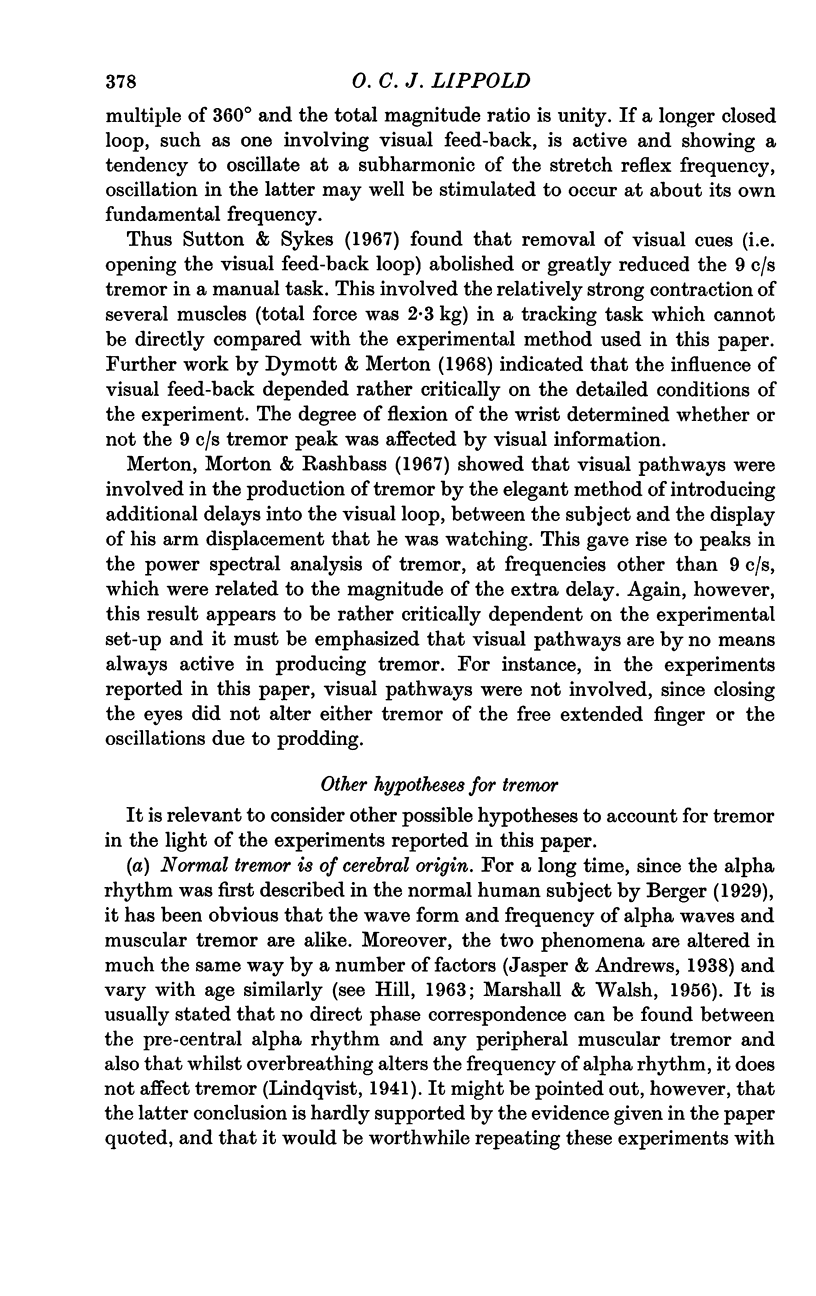
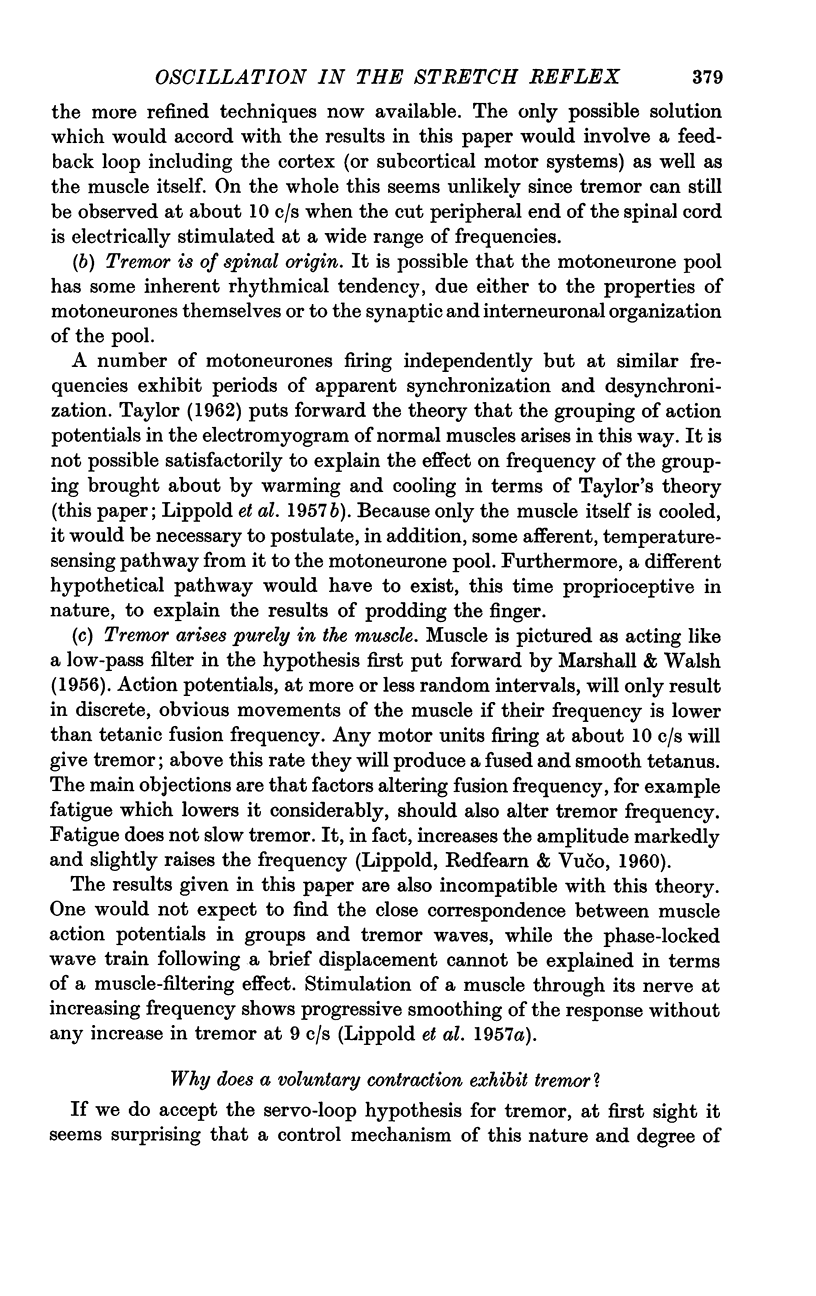
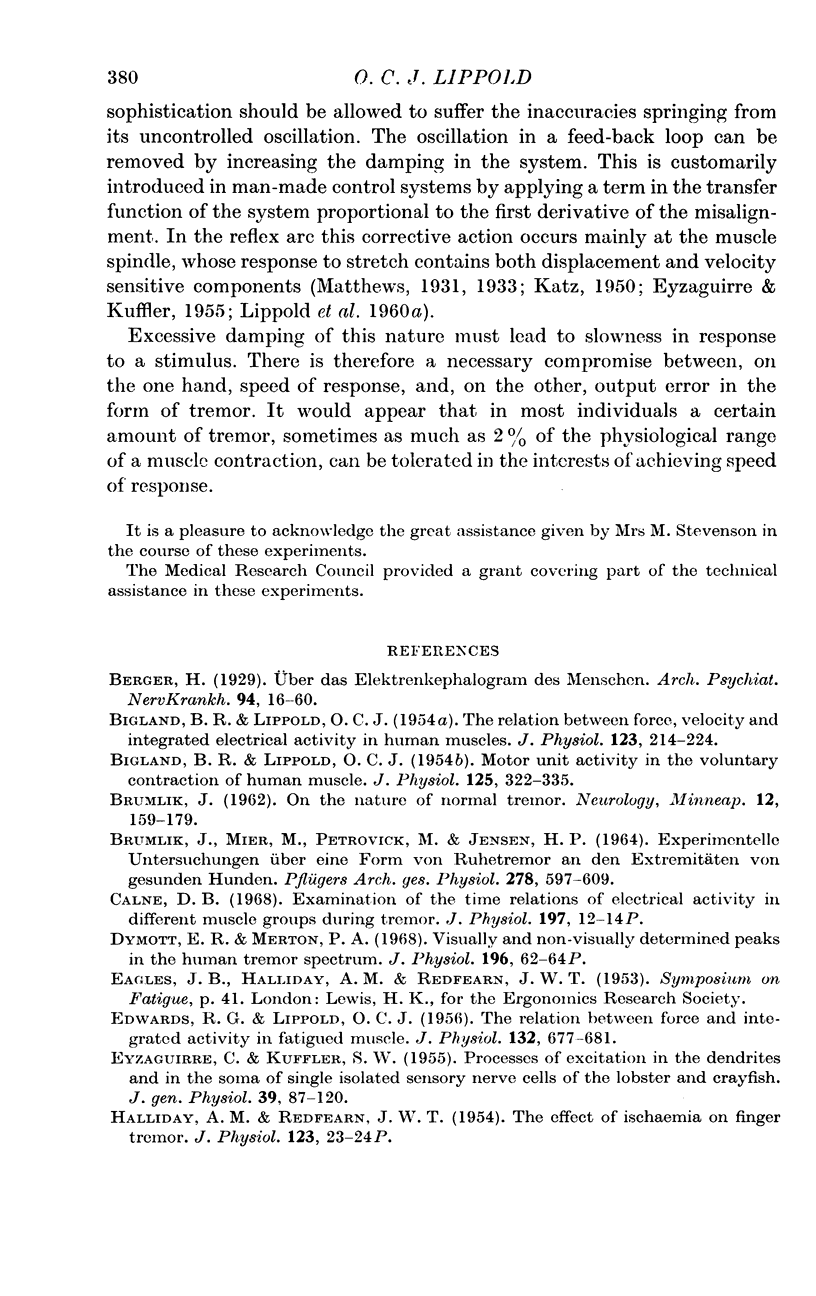
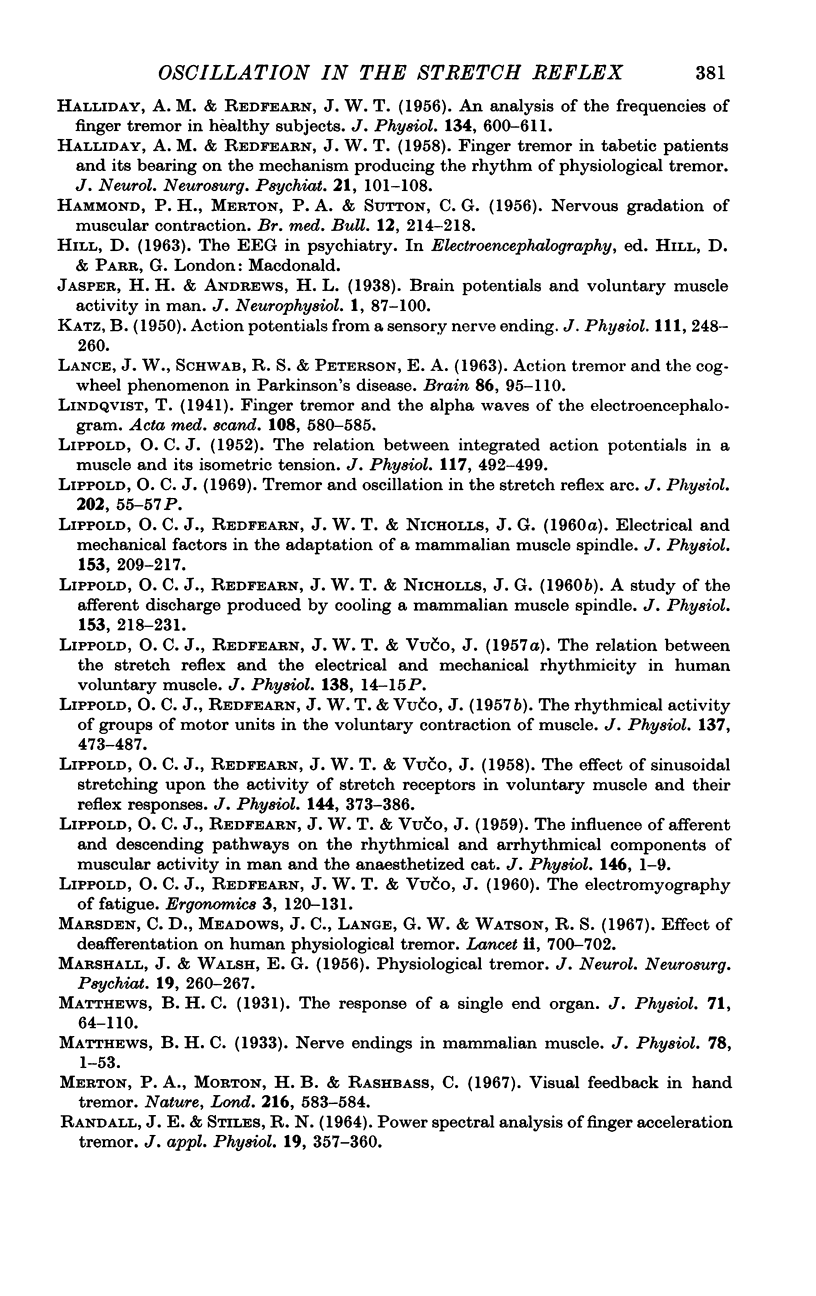
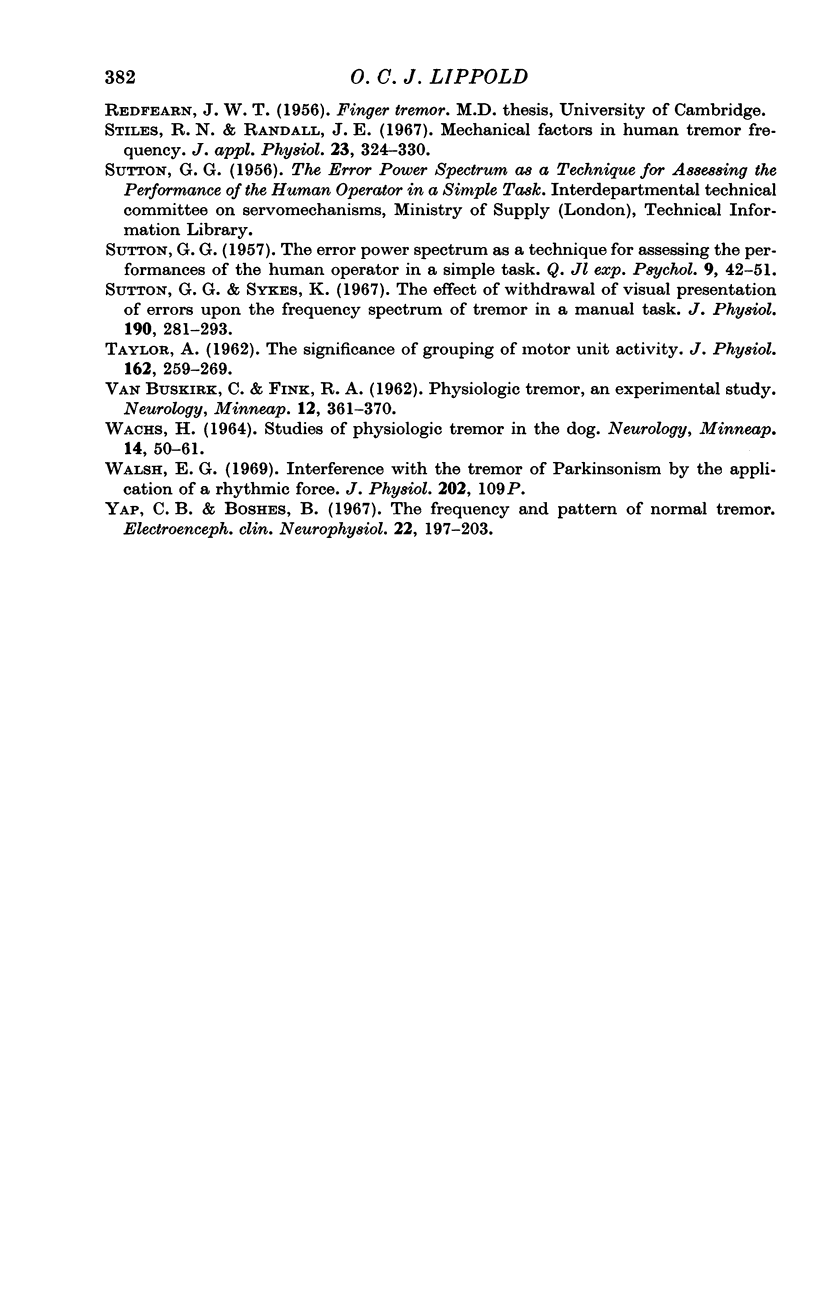
Selected References
These references are in PubMed. This may not be the complete list of references from this article.
- BIGLAND B., LIPPOLD O. C. Motor unit activity in the voluntary contraction of human muscle. J Physiol. 1954 Aug 27;125(2):322–335. doi: 10.1113/jphysiol.1954.sp005161. [DOI] [PMC free article] [PubMed] [Google Scholar]
- BIGLAND B., LIPPOLD O. C. The relation between force, velocity and integrated electrical activity in human muscles. J Physiol. 1954 Jan;123(1):214–224. doi: 10.1113/jphysiol.1954.sp005044. [DOI] [PMC free article] [PubMed] [Google Scholar]
- BRUMLIK J., MIER M., PETROVICK M., JENSEN H. P. EXPERIMENTELLE UNTERSUCHUNGEN UEBER EINE FORM VON RUHETREMOR AN DEN EXTREMITAETEN VON GESUNDEN HUNDEN. Pflugers Arch Gesamte Physiol Menschen Tiere. 1964 Jan 30;278:597–609. [PubMed] [Google Scholar]
- BRUMLIK J. On the nature of normal tremor. Neurology. 1962 Mar;12:159–179. doi: 10.1212/wnl.12.3.159. [DOI] [PubMed] [Google Scholar]
- Calne D. B. Examination of the time relations of electrical activity in different muscle groups during tremor. J Physiol. 1968 Jul;197(1):12P–14P. [PubMed] [Google Scholar]
- EDWARDS R. G., LIPPOLD O. C. The relation between force and integrated electrical activity in fatigued muscle. J Physiol. 1956 Jun 28;132(3):677–681. doi: 10.1113/jphysiol.1956.sp005558. [DOI] [PMC free article] [PubMed] [Google Scholar]
- EYZAGUIRRE C., KUFFLER S. W. Processes of excitation in the dendrites and in the soma of single isolated sensory nerve cells of the lobster and crayfish. J Gen Physiol. 1955 Sep 20;39(1):87–119. doi: 10.1085/jgp.39.1.87. [DOI] [PMC free article] [PubMed] [Google Scholar]
- HALLIDAY A. M., REDFEARN J. W. An analysis of the frequencies of finger tremor in healthy subjects. J Physiol. 1956 Dec 28;134(3):600–611. doi: 10.1113/jphysiol.1956.sp005668. [DOI] [PMC free article] [PubMed] [Google Scholar]
- HALLIDAY A. M., REDFEARN J. W. Finger tremor in tabetic patients and its bearing on the mechanism producing the rhythm of physiological tremor. J Neurol Neurosurg Psychiatry. 1958 May;21(2):101–108. doi: 10.1136/jnnp.21.2.101. [DOI] [PMC free article] [PubMed] [Google Scholar]
- HALLIDAY A. M., REDFEARN J. W. The effect of ischaemia on finger tremor. J Physiol. 1954 Feb 26;123(2):23–4P. [PubMed] [Google Scholar]
- HAMMOND P. H., MERTON P. A., SUTTON G. G. Nervous gradation of muscular contraction. Br Med Bull. 1956 Sep;12(3):214–218. doi: 10.1093/oxfordjournals.bmb.a069553. [DOI] [PubMed] [Google Scholar]
- KATZ B. Action potentials from a sensory nerve ending. J Physiol. 1950 Oct 16;111(3-4):248–260. doi: 10.1113/jphysiol.1950.sp004478. [DOI] [PMC free article] [PubMed] [Google Scholar]
- LANCE J. W., SCHWAB R. S., PETERSON E. A. Action tremor and the cogwheel phenomenon in Parkinson's disease. Brain. 1963 Mar;86:95–110. doi: 10.1093/brain/86.1.95. [DOI] [PubMed] [Google Scholar]
- LIPPOLD O. C. J. The relation between integrated action potentials in a human muscle and its isometric tension. J Physiol. 1952 Aug;117(4):492–499. doi: 10.1113/jphysiol.1952.sp004763. [DOI] [PMC free article] [PubMed] [Google Scholar]
- LIPPOLD O. C., NICHOLLS J. G., REDFEARN J. W. A study of the afferent discharge produced by cooling a mammalian muscle spindle. J Physiol. 1960 Sep;153:218–231. doi: 10.1113/jphysiol.1960.sp006530. [DOI] [PMC free article] [PubMed] [Google Scholar]
- LIPPOLD O. C., NICHOLLS J. G., REDFEARN J. W. Electrical and mechanical factors in the adaptation of a mammalian muscle spindle. J Physiol. 1960 Sep;153:209–217. doi: 10.1113/jphysiol.1960.sp006529. [DOI] [PMC free article] [PubMed] [Google Scholar]
- LIPPOLD O. C., REDFEARN J. W., VUCO J. The effect of sinusoidal stretching upon the activity of stretch receptors in voluntary muscle and their reflex responses. J Physiol. 1958 Dec 30;144(3):373–386. doi: 10.1113/jphysiol.1958.sp006108. [DOI] [PMC free article] [PubMed] [Google Scholar]
- LIPPOLD O. C., REDFEARN J. W., VUCO J. The rhythmical activity of groups of motor units in the voluntary contraction of muscle. J Physiol. 1957 Aug 6;137(3):473–487. doi: 10.1113/jphysiol.1957.sp005828. [DOI] [PMC free article] [PubMed] [Google Scholar]
- MARSHALL J., WALSH E. G. Physiological tremor. J Neurol Neurosurg Psychiatry. 1956 Nov;19(4):260–267. doi: 10.1136/jnnp.19.4.260. [DOI] [PMC free article] [PubMed] [Google Scholar]
- Marsden C. D., Meadows J. C., Lange G. W., Watson R. S. Effect of deafferentation on human physiological tremor. Lancet. 1967 Sep 30;2(7518):700–702. doi: 10.1016/s0140-6736(67)90977-4. [DOI] [PubMed] [Google Scholar]
- Matthews B. H. Nerve endings in mammalian muscle. J Physiol. 1933 Apr 13;78(1):1–53. doi: 10.1113/jphysiol.1933.sp002984. [DOI] [PMC free article] [PubMed] [Google Scholar]
- Matthews B. H. The response of a single end organ. J Physiol. 1931 Jan 21;71(1):64–110. doi: 10.1113/jphysiol.1931.sp002718. [DOI] [PMC free article] [PubMed] [Google Scholar]
- Merton P. A., Morton H. B., Rashbass C. Visual feedback in hand tremor. Nature. 1967 Nov 11;216(5115):583–584. doi: 10.1038/216583a0. [DOI] [PubMed] [Google Scholar]
- RANDALL J. E., STILES R. N. POWER SPECTRAL ANALYSIS OF FINGER ACCELERATION TREMOR. J Appl Physiol. 1964 Mar;19:357–360. doi: 10.1152/jappl.1964.19.2.357. [DOI] [PubMed] [Google Scholar]
- Stiles R. N., Randall J. E. Mechanical factors in human tremor frequency. J Appl Physiol. 1967 Sep;23(3):324–330. doi: 10.1152/jappl.1967.23.3.324. [DOI] [PubMed] [Google Scholar]
- Sutton G. G., Sykes K. The effect of withdrawal of visual presentation of errors upon the frequency spectrum of tremor in a manual task. J Physiol. 1967 May;190(2):281–293. doi: 10.1113/jphysiol.1967.sp008208. [DOI] [PMC free article] [PubMed] [Google Scholar]
- TAYLOR A. The significance of grouping of motor unit activity. J Physiol. 1962 Jul;162:259–269. doi: 10.1113/jphysiol.1962.sp006930. [DOI] [PMC free article] [PubMed] [Google Scholar]
- VAN BUSKIRK C., FINK R. A. Physiologic tremor. An experimental study. Neurology. 1962 May;12:361–370. doi: 10.1212/wnl.12.5.361. [DOI] [PubMed] [Google Scholar]
- WACHS H. STUDIES OF PHYSIOLOGIC TREMOR IN THE DOG. Neurology. 1964 Jan;14:50–61. doi: 10.1212/wnl.14.1.50. [DOI] [PubMed] [Google Scholar]
- Walsh E. G. Interference with the tremor of Parkinsonism by the application of a rhythmic force. J Physiol. 1969 Jun;202(2):109P+–109P+. [PubMed] [Google Scholar]
- Yap C. B., Boshes B. The frequency and pattern of normal tremor. Electroencephalogr Clin Neurophysiol. 1967 Mar;22(3):197–203. doi: 10.1016/0013-4694(67)90221-0. [DOI] [PubMed] [Google Scholar]


